The Effect of Chemical and Thermal Treatment for Desizing on the Properties and Chemical Functional Groups of Carbon Fiber
Abstract
:1. Introduction
2. Experimental Details
3. Results and Discussion
3.1. Characteristic Change of Carbon Fiber According to Desizing Process Conditions
3.2. Changes in Chemical Properties of Carbon Fibers Depending on Desizing Process Parameters
3.3. Changes in Chemical Properties of Carbon Fibers Depending on Desizing Process Parameters
4. Conclusions
Author Contributions
Funding
Institutional Review Board Statement
Informed Consent Statement
Data Availability Statement
Conflicts of Interest
References
- Yao, S.S.; Jin, F.L.; Rhee, K.Y.; Hui, D.; Park, S.J. Recent advances in carbon-fiber-reinforced thermoplastic composites: A review. Compos. Part B Eng. 2018, 142, 241–250. [Google Scholar] [CrossRef]
- Xu, H.; Zhang, X.; Liu, D.; Yan, C.; Chen, X.; Hui, D.; Zhu, Y. Cyclomatrix-type polyphosphazene coating: Improving interfacial property of carbon fiber/epoxy composites and preserving fiber tensile strength. Compos. Part B Eng. 2016, 93, 244–251. [Google Scholar] [CrossRef]
- Choi, M.H.; Jeon, B.H.; Chung, I.J. The effect of coupling agent on electrical and mechanical properties of carbon fiber/phenolic resin composites. Polymers 2000, 41, 3243–3252. [Google Scholar] [CrossRef]
- Jiang, B.; Zhang, T.; Zhao, L.; Huang, Y. Interfacially reinforced carbon fiber composites by grafting modified methylsilicone resin. Compos. Sci. Technol. 2017, 140, 39–45. [Google Scholar] [CrossRef]
- Feng, P.; Song, G.; Li, X.; Xu, H.; Xu, L.; Lv, D.; Zhu, X.; Huang, Y.; Ma, L. Effects of different rigid-flexible structures of carbon fibers surface on the interfacial microstructure and mechanical properties of carbon fiber/epoxy resin composites. J. Colloid Interface Sci. 2021, 583, 13–23. [Google Scholar] [CrossRef] [PubMed]
- Poor, D.I.; Geier, N.; Pereszlai, G.; Xu, J. A critical review of the drilling of CFRP composites: Burr formation, characterisation and challenges. Compos. Part B Eng. 2021, 223, 109155. [Google Scholar] [CrossRef]
- Zorko, D.; Tavcar, J.; Bizjak, M.; Sturm, R.; Bergant, Z. High cycle fatigue behaviour of autoclave-cured woven carbon fibre-reinforced polymer composite gears. Polym. Test. 2021, 102, 107339. [Google Scholar] [CrossRef]
- Lefeuvre, A.; Garnier, S.; Jacquemin, L.; Pillain, B.; Sonnemann, D. Anticipating in-use stocks of carbon fiber reinforced polymers and related waste flows generated by the commercial aeronautical sector until 2050. Resour. Conserv. Recycl. 2017, 125, 264–272. [Google Scholar] [CrossRef]
- Chin, K.Y.; Shiue, A.; Wu, Y.J.; Chang, S.M.; Li, Y.F.; Shen, M.Y.; Leggett, G. Studies on Recycling Silane Controllable Recovered Carbon Fiber from Waste CFRP. Sustainability 2022, 14, 700. [Google Scholar] [CrossRef]
- Zhang, J.; Chevali, V.S.; Wang, H.; Wang, C.H. Current status of carbon fibre and carbon fibre composites recycling. Compos. Part B Eng. 2020, 193, 108053. [Google Scholar] [CrossRef]
- Oliveux, G.; Dandy, L.O.; Leeke, G.A. Current status of recycling of fibre reinforced polymers: Review of technologies, reuse and resulting properties. Prog. Mater. Sci. 2015, 72, 61–99. [Google Scholar] [CrossRef]
- Sun, H.; Guo, G.; Memon, S.A.; Xu, W.; Zhang, Q.; Zhu, J.H.; Xing, F. Recycling of carbon fibers from carbon fiber reinforced polymer using electrochemical method. Compos. Part A Appl. Sci. Manuf. 2015, 78, 10–17. [Google Scholar] [CrossRef]
- Pei, C.; Chen, P.Y.; Kong, S.C.; Wu, J.; Zhu, J.H.; Xing, F. Recyclable separation and recovery of carbon fibers from CFRP composites: Optimization and mechanism. Sep. Purif. Technol. 2021, 278, 119591. [Google Scholar] [CrossRef]
- Chen, C.H.; Chiang, C.L.; Wang, J.X.; Shen, M.Y. A circular economy study on the characterization and thermal properties of thermoplastic composite created using regenerated carbon fiber recycled from waste thermoset CFRP bicycle part as reinforcement. Compos. Sci. Technol. 2022, 230, 109761. [Google Scholar] [CrossRef]
- Howarth, J.; Mareddy, S.S.R.; Mativenga, P.T. Energy intensity and environmental analysis of mechanical recycling of carbon fibre composite. J. Clean. Prod. 2014, 81, 46–50. [Google Scholar] [CrossRef]
- Song, J.H. Tensile strength of polypropylene carbon fiber composite for heat treatment conditions. J. Korean Soc. Mech. Technol. 2020, 22, 107–111. [Google Scholar] [CrossRef]
- Zhang, T.; Zhao, Y.; Li, H.; Zhang, B. Effect of polyurethane sizing on carbon fibers surface and interfacial adhesion of fiber/polyamide 6 composites. J. Appl. Polym. Sci. 2018, 135, 46111. [Google Scholar] [CrossRef]
- Kiss, P.; Glinz, J.; Stadlbauer, W.; Burgstaller, C.; Archodoulaki, V.M. The effect of thermally desized carbon fibre reinforcement on the flexural and impact properties of PA6, PPS and PEEK composite laminates: A comparative study. Compos. Part B Eng. 2021, 215, 108844. [Google Scholar] [CrossRef]
- Hubbe, M.; Koukoulas, A. Wet-Laid Nonwovens Manufacture–Chemical Approaches Using Synthetic and Cellulosic Fibers. BioResources 2016, 11, 5500–5552. [Google Scholar] [CrossRef]
- Kang, Y.J.; Song, S.H. Effects of Surfactants on Dispersion Behavior of Vectran® in Water(Ⅱ)- Study on the Manufacture and Properties of Wet-laid Nonwoven Fabrics. Text. Color. Finish. 2015, 27, 327–333. [Google Scholar] [CrossRef]
- Lee, H.K.; Kim, G.H.; Kim, K.E.; Kim, H.Y.; Kim, D.U. Effect of Plasma Treatment Condition on Mechanical and Chemical Properties of Carbon Fibers. J. Mater. Eng. Perform. 2022, 32, 415–422. [Google Scholar] [CrossRef]
- Woodhead, A.L.; Souza, M.L.D.; Church, J.S. An investigation into the surface heterogeneity of nitric acid oxidized carbon fiber. Appl. Surf. Sci. 2017, 401, 79–88. [Google Scholar] [CrossRef]
- Eyckens, D.J.; Arnold, C.L.; Simon, Z.; Gengenbach, T.R.; Pinson, J.; Wickramasingha, Y.A.; Henderson, L.C. Covalent sizing surface modification as a route to improved interfacial adhesion in carbon fibre-epoxy composites. Compos. Part A Appl. Sci. Manuf. 2021, 140, 106147. [Google Scholar] [CrossRef]
- Park, S.J.; Oh, J.S.; Suh, D.H. Crack Resistance Properties of Anodized Carbon Fibers/Epoxy Matrix Composites. Korean Chem. Eng. Res. 2004, 42, 102–106. [Google Scholar]
- Ma, K.; Chen, P.; Wang, B.; Cui, G.; Xu, X. A study of the effect of oxygen plasma treatment on the interfacial properties of carbon fiber/epoxy composites. J. Appl. Polym. Sci. 2010, 118, 1606–1614. [Google Scholar] [CrossRef]
- Tian, H.; Yao, Y.; Liu, D.; Li, Y.; Jv, R.; Xiang, G.; Xiang, A. Enhanced Interfacial Adhesion and Properties of Polypropylene/Carbon Fiber Composites by Fiber Surface Oxidation in Presence of a Compatibilizer. Polym. Compos. 2019, 40, 654–662. [Google Scholar] [CrossRef]
- Kim, J.H.; Lee, C.J.; Min, K.D.; Hwang, B.U.; Kang, D.G.; Choi, D.H.; Joo, J.; Jung, S.B. Intense pulsed light surface treatment for improving adhesive bonding of aluminum and carbon fiber reinforced plastic (CFRP). Compos. Struct. 2021, 258, 113364. [Google Scholar] [CrossRef]
- Jang, J.S.; Yang, H.J. The effect of surface treatment on the performance improvement of carbon fiber/polybenzoxazine composites. J. Mater. Sci. 2000, 35, 2297–2303. [Google Scholar] [CrossRef]
- Ibarra, L.; Panos, D. Carbon fibre oxidation, textural and surface changes. Die Angew. Makromol. Chem. 1997, 248, 201–215. [Google Scholar] [CrossRef]
- Ahmed, J.K.; Hamzah, A.F.; Hamed, A. Thermal and Chemical Etching of Carbon Fiber. J. Eng. Technol. 2017, 7, 519–526. [Google Scholar]
- Liu, H.; Zhao, Y.; Chen, F.; Li, N.; Sun, M.; Zhang, T.; Sun, T.; Wang, K.; Du, S. Effects of polyetherimide sizing involving carbon nanotubes on interfacial performance of carbon fiber/polyetheretherketone composites. Polym. Compos. 2021, 42, 931–943. [Google Scholar] [CrossRef]
- Hu, J.; Li, F.; Wang, B.; Zhang, H.; Ji, C.; Wang, S.; Zhou, Z. A two-step combination strategy for significantly enhancing the interfacial adhesion of CF/PPS composites: The liquid-phase oxidation followed by grafting of silane coupling agent. Compos. Part B Eng. 2020, 191, 107966. [Google Scholar] [CrossRef]
- Choi, S.H.; Yoo, M.H.; Park, Y.S.; Moon, M.S.; Song, J.H.; Oh, J.H.; Kang, S.J. A Study on the Dispersant and Binder for Manufacturing the Carbon fiber veil. Korean Soc. Automot. Eng. 2016, 1, 33–35. [Google Scholar]
- Kim, G.H.; Lee, H.K.; Kim, K.E.; Kim, D.U. Effect of heat treatment atmosphere and temperature on properties of carbon fiber. Polymers 2022, 14, 2412. [Google Scholar] [CrossRef] [PubMed]
- Jian, L. Effect of sizing agent on interfacial properties of carbon fiber-reinforced PMMA composite. Compos. Adv. Mater. 2021, 30, 2633366X20978657. [Google Scholar] [CrossRef]
- Kim, G.H.; Lee, H.K.; Kim, M.S.; Kim, D.U. Investigating the Effects of Nitric Acid Treatments on the Properties of Recycled Carbon Fiber. Polymers 2023, 15, 824. [Google Scholar] [CrossRef] [PubMed]
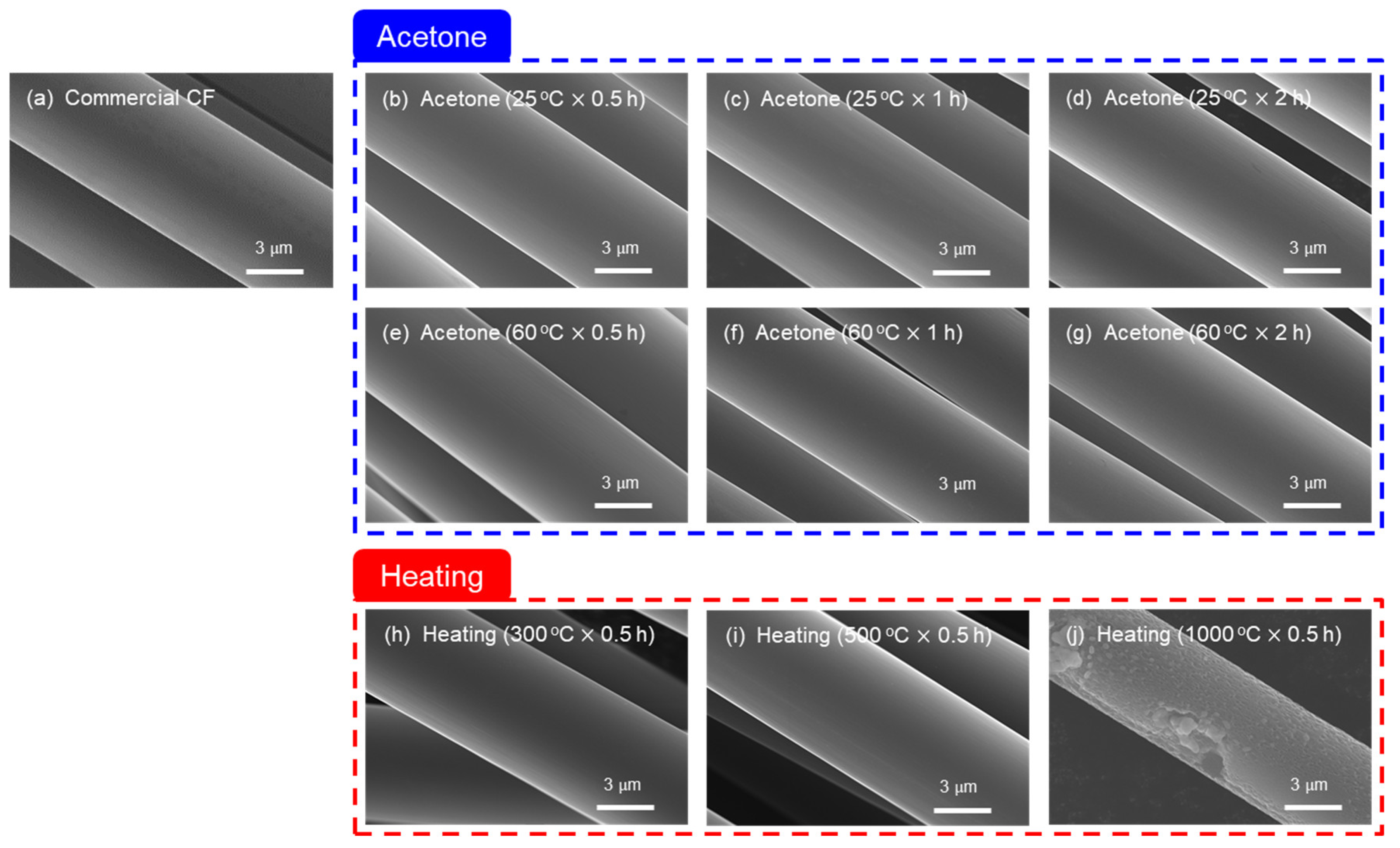
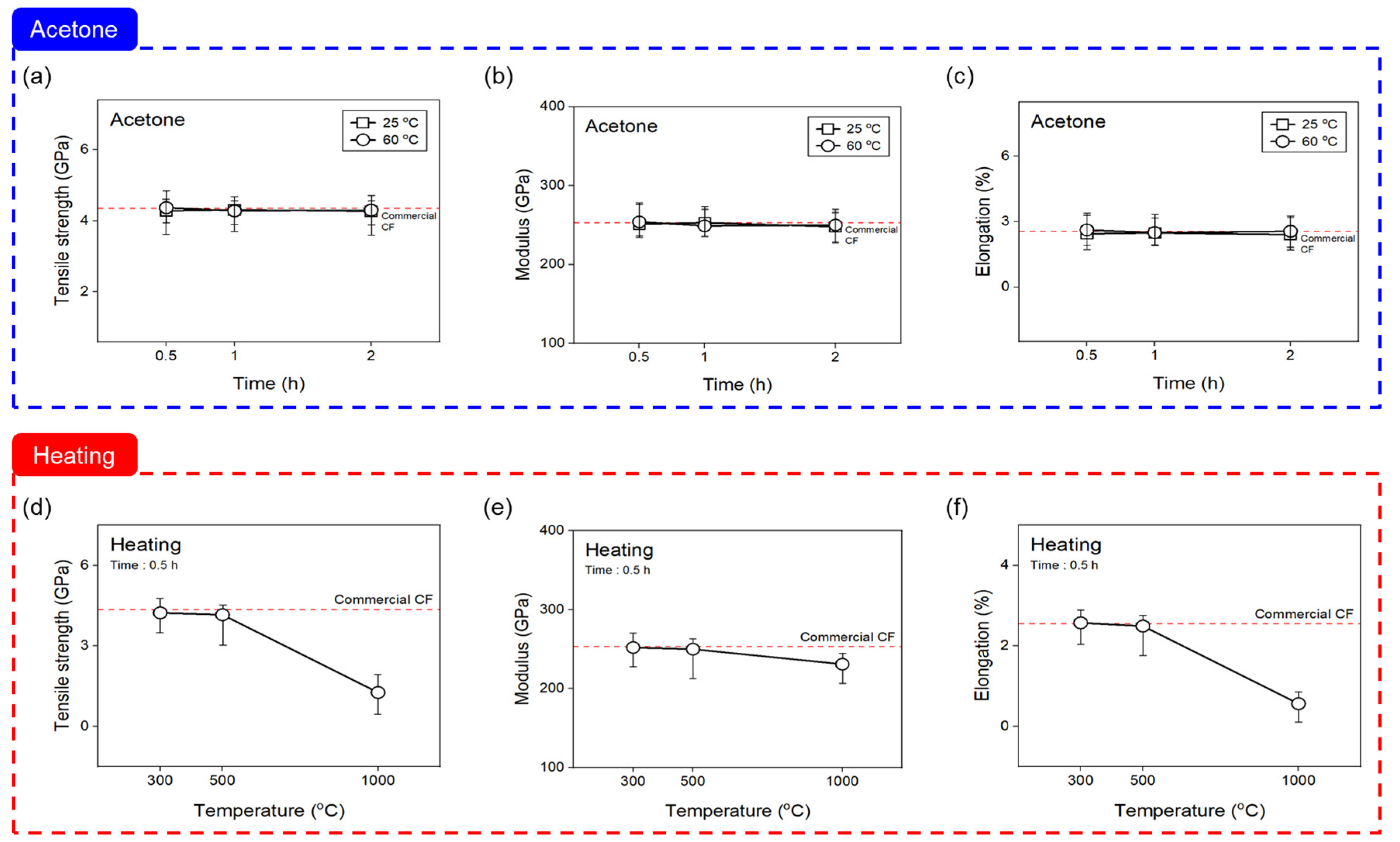
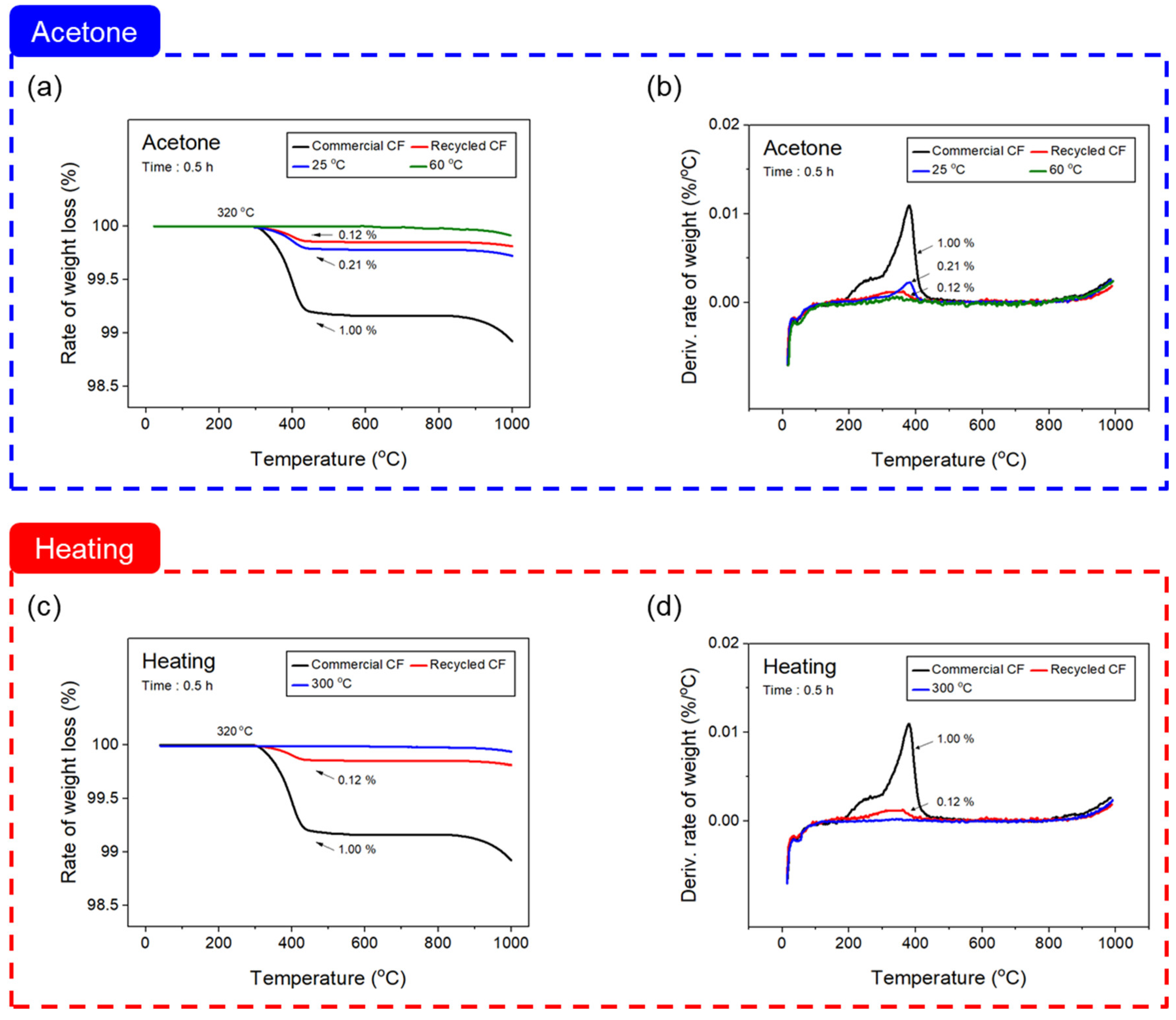

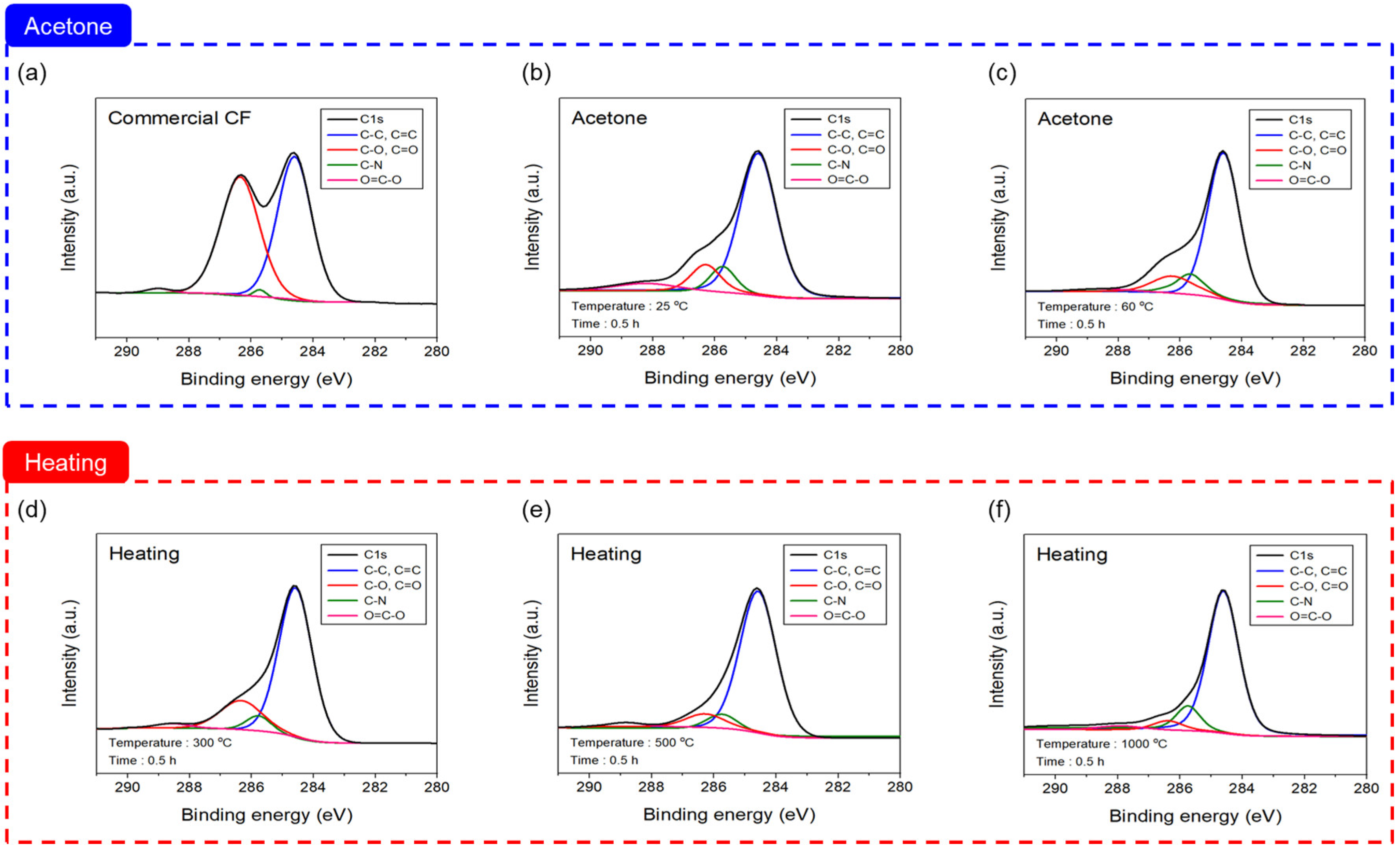


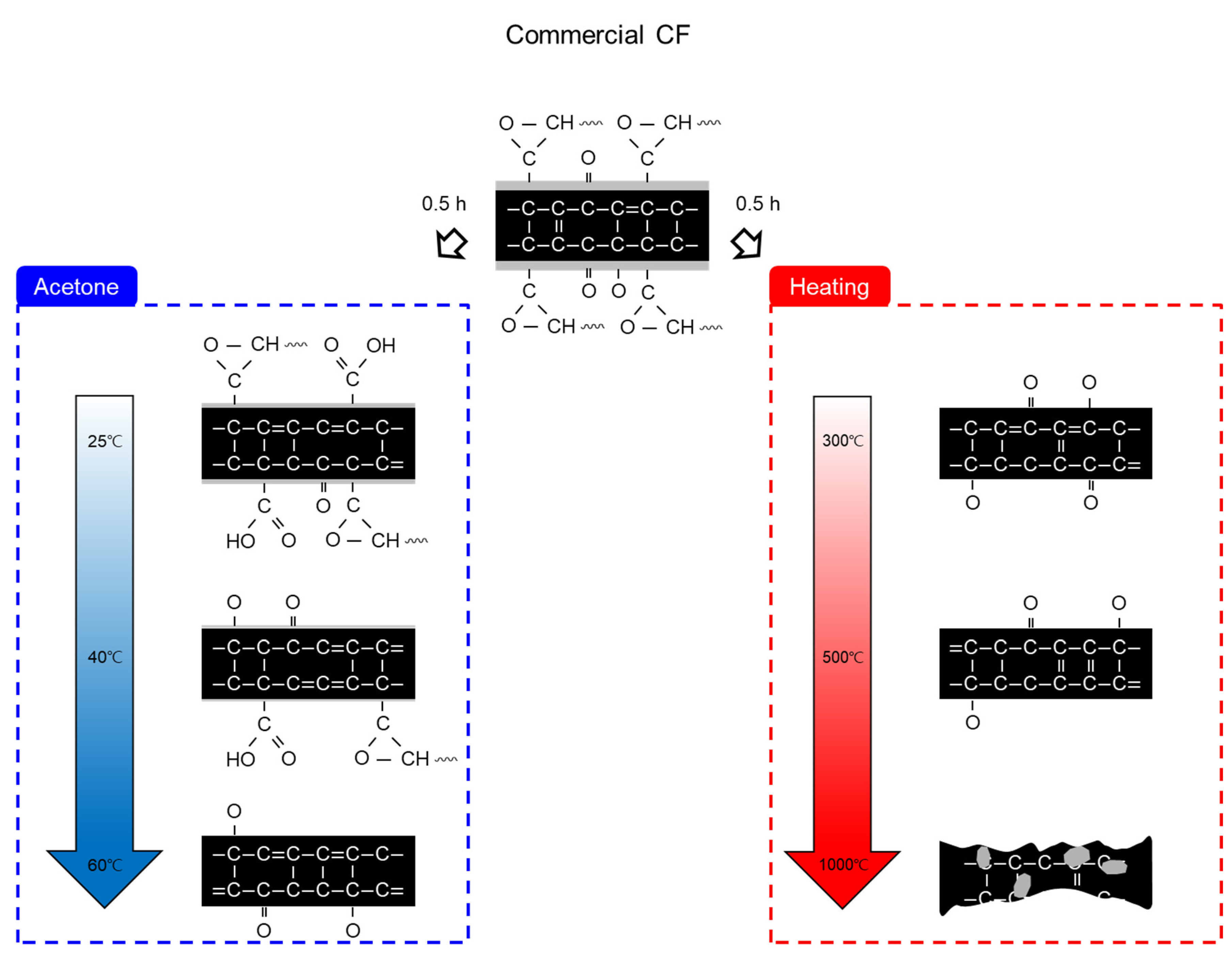
| Type | Commercial CF | Recycled CF |
|---|---|---|
| Tensile strength (GPa) | 4.49 | 3.45 |
| Modulus (GPa) | 261 | 256 |
| Elongation (%) | 2.62 | 2.08 |
| Density (g/cm3) | 1.80 | 1.80 |
| Desizing Process | Temperature | Elemental Composition (at. %) | O/C | |||
|---|---|---|---|---|---|---|
| Carbon | Oxygen | Nitrogen | Silicon | |||
| Commercial CF | 76.31 | 21.31 | 0.75 | 1.63 | 0.28 | |
| Acetone | 25 °C | 77.85 | 18.06 | 1.47 | 2.62 | 0.23 |
| 60 °C | 79.83 | 16.46 | 1.88 | 1.83 | 0.20 | |
| Heating | 300 °C | 80.14 | 16.97 | 1.17 | 1.72 | 0.21 |
| 500 °C | 84.45 | 15.13 | 1.19 | 1.23 | 0.18 | |
| 1000 °C | 86.64 | 9.47 | 0.75 | 3.15 | 0.11 | |
| Desizing Process | Temperature | C1s (at. %) | |||
|---|---|---|---|---|---|
| C-C, C=C | C-O, C=O | C-N | O=C-O | ||
| Commercial CF | 50.85 | 47.10 | 1.98 | 0.07 | |
| Acetone | 25 °C | 68.35 | 18.10 | 6.88 | 6.67 |
| 60 °C | 73.57 | 16.36 | 7.95 | 2.12 | |
| Heating | 300 °C | 77.37 | 19.25 | 1.46 | 1.92 |
| 500 °C | 85.65 | 10.05 | 1.39 | 2.91 | |
| 1000 °C | 84.15 | 5.43 | 9.01 | 1.41 | |
Disclaimer/Publisher’s Note: The statements, opinions and data contained in all publications are solely those of the individual author(s) and contributor(s) and not of MDPI and/or the editor(s). MDPI and/or the editor(s) disclaim responsibility for any injury to people or property resulting from any ideas, methods, instructions or products referred to in the content. |
© 2023 by the authors. Licensee MDPI, Basel, Switzerland. This article is an open access article distributed under the terms and conditions of the Creative Commons Attribution (CC BY) license (https://creativecommons.org/licenses/by/4.0/).
Share and Cite
Kim, K.; Kim, M.; Kim, G.; Kim, D. The Effect of Chemical and Thermal Treatment for Desizing on the Properties and Chemical Functional Groups of Carbon Fiber. Materials 2023, 16, 6732. https://doi.org/10.3390/ma16206732
Kim K, Kim M, Kim G, Kim D. The Effect of Chemical and Thermal Treatment for Desizing on the Properties and Chemical Functional Groups of Carbon Fiber. Materials. 2023; 16(20):6732. https://doi.org/10.3390/ma16206732
Chicago/Turabian StyleKim, Kyungeun, Minsu Kim, Gyungha Kim, and Daeup Kim. 2023. "The Effect of Chemical and Thermal Treatment for Desizing on the Properties and Chemical Functional Groups of Carbon Fiber" Materials 16, no. 20: 6732. https://doi.org/10.3390/ma16206732
APA StyleKim, K., Kim, M., Kim, G., & Kim, D. (2023). The Effect of Chemical and Thermal Treatment for Desizing on the Properties and Chemical Functional Groups of Carbon Fiber. Materials, 16(20), 6732. https://doi.org/10.3390/ma16206732






